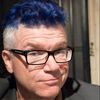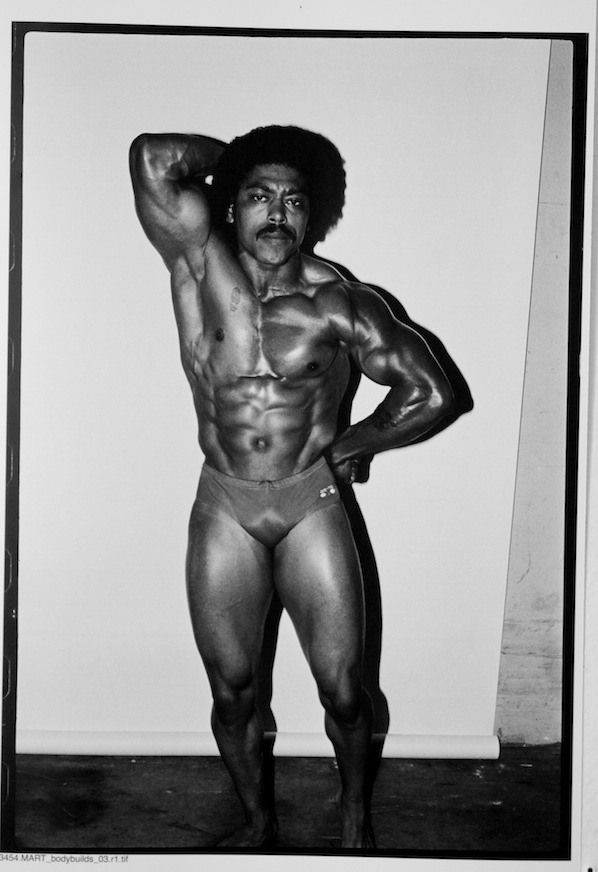By now Los Angeles is awakening to a Pacific Standard Time hangover and if we never see another black and white photo of a wannabe beatnik sucking up to Walter Hopps we might make it through the decade ahead in one piece. It took me a while but I finally found a PST exhibit that was actually focused -- really, it must have snuck past the Getty's seeming mandate to water down all important art by piling on with tangential artists in order to water down all but the pre-approved usual suspects. Additionally this was perhaps the youngest artist making rigorous work in the time frame under consideration for the PST brawl.
Two series of work from the late 1970s by Daniel Joseph Martinez squeaked into the Getty's mishmash at Culver City's non-profit LAXART gallery. The La Cienega Boulvard gallery space didn't take the easy PST way out and spoon-feed New York some "LaLa Land" story. These two photographic series on display dealt with body augmentation as a form of irrepressible politics were presented. Unlike ninety percent of the PST exhibits that looked like the history of art school professor art, the conceptual prescience and elegant presentation of subjects that today border on both the ubiquitous and nostalgic carried a dramatic staying power. I had to visit this show three times to tackle the layers of possibility that Martinez was mining during the Jimmy Carter administration, and anarchic sub-epoch that the Getty couldn't quite whitewash into minimal oblivion.
MAT GLEASON: So Daniel, you are one of the busiest artists out there. Your Project at LAXART is work from 1978-79 that has never been shown -- were you eager to be part of Pacific Standard Time or were these pictures always just ready to be worked on and then something else always came along?
DANIEL JOSEPH MARTINEZ: These two series are now some 33 years old. They were at the time in the studio but left in a box over all these years. The beauty pageant series negatives were destroyed by a flood, so the prints in the show are the original prints from the late 70s. Somehow the prints were able to survive. The body builders are new light jet prints done for the exhibition.
When Lauri Firstenberg asked me to participate in PST I was excited, the opportunity to exhibit both series together in the proper context had been something I had wanted to do for a very long time. The conversation between the two sets of work has the potential to expand and question each other in a 21st century discourse through the subjects and visual representation.
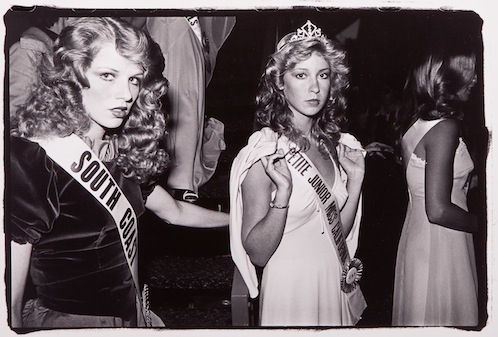
MG: There is a prescience in you spotting extreme behavior that has now become quite commonplace -- did you have any imagination about the body issues you documented becoming "the new normal" in the future?
DJM: The politics of the body has continually been at the forefront of human behavior and analysis. This trajectory started with Darwin's ideas of evolution, which set fires across numerous boundaries. Then humanity added the concept of mutation that is very exciting due to its uncontrollability ... hence its social and political agency. There is an amplification of possibilities like the ideas of Ray Kurzweil and a bio-mechanical future. There is the augmentation of the body through technological prosthetics and the now common use of technology for the manipulation of the body in form and image.
MG: At the same time you were documenting these body maintenance obsessions in men and women, the punk movement was peaking with extremes in fashion and appearance on display, not to mention the radical nature of the art and music the movement was producing. Do you see it all now as reflecting a larger tenor of the times outside of the specific issues you were investigating?
DJM: I think your observations here are reflections of simultaneous social movements dispersed in many different directions. Punk music and fashion has had a lasting effect. The issues most at risk seem to continuously center themselves on power and control. In the most utopic condition we would seek debate and autonomy with social and political freedom in an open society. Instead we have a global meltdown, free market capitalism, democratic disaster. I wonder if it's just that we are alive now to witness the condition of living in the empire, or has this always been the case, this economic and military power, and we just did not witness it. Isn't it the speed of the exchange and dissemination of image and propaganda that we are involved in every day? The social media networking and Internet's massive amounts of data we are confronted with overwhelm our ability to make any practical use of the information.
The idea of immaterial labor has surfaced. Questions arising in an attempt to contemplate if we can imagine a future of new possibilities and potential. Can we detach ourselves from the weight of the past ideologies and methods and genuinely set in motion a condition where we grasp history and the future as the fuel to strive for a condition of building a fluid and ever-changing future, instead of the dogmatic wealth-driven nightmare we are all responsible for perpetuating?
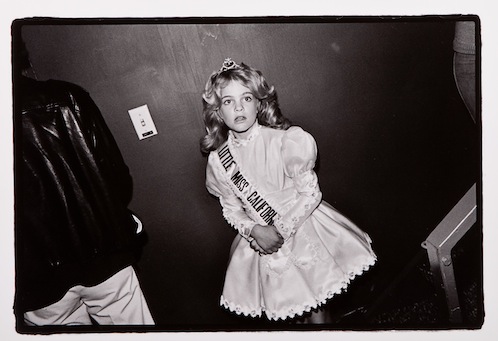
MG: Did you know any of the people you were shooting? Is anyone you documented aware of the exhibit at LAXART?
DJM: No I didn't know anyone in the photos. I was aware, though, that the men who were competitive bodybuilders were associated with the same circuit that Arnold Schwarzenegger was competing in. Say if we look at "Pumping Iron" and trace the history of the rise of Arnold's fame and success in the United States that led him to films and then on to being governor of California. I wish someone in the photographs had been at the exhibit or would come to the show. I wonder what their response would be to their own image from so long ago?
MG: Plastic surgery is the new normal for those who can afford it and the body building freak show mutated into a steroids controversy in professional sports. Women get "fake" breasts to compete for attention and athletes cheat with body building supplements to get fame. It is easy to draw a linear narrative in hindsight -- is the value of art steeped in theory at all useful as a predictive device or just as a reflection of one moment in time of where the culture is at?
DJM: In this instance you don't need theory at all. What you are describing is hard-wired into the species, all we need to do is look out the door, a momentary glance at popular culture to tell us of the implied and socially inherited cultural norms too which we are supposed to aspire. It so much simpler to live in state of fantasy and projected cultural norms. Why bother, we all live in the comfort of the empire. It results in becoming numb, lazy and pathological liars.
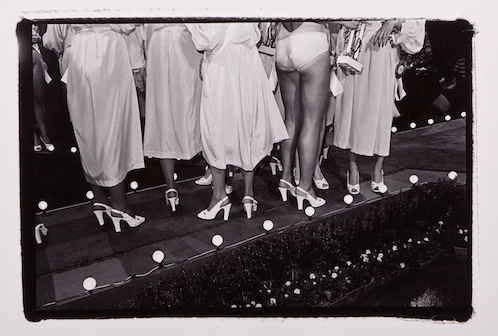
MG: Do you see a lot of discourse in the art world and in academia mimicking beauty pageant contestants and bodybuilders in their attempt to stick out without necessarily having substance - and if so, is there an antidote amidst the politics of these systems?
DJM: We are at a strange and wondrous moment right now. On one hand artists have been duped and neutered to give over all their imagination, power and intelligence to others, allowing for the making of some of the most indifferent, uninspired work I have seen in years. When the response to the current Whitney Biennial is we are all happy and the suggestion is look back and then look further back when art was passive and unchallenging it makes it so simple to make any argument you want. Then you can just overlay on to it layers of social photoshopping, its easy to do now you just need a new I phone app. Push a button and its done, onto the meaning of the work. Decoration and family fun is the mantra of the day, rather than challenging and thought provoking, taking advantage of the great opportunity - this state of transition, artists could be looking forward to a new and unknown future. Risk in every form should be at every level should be prioritized at all costs. The very core of our existence should be investing in ideas that risk failure at every level, at every instance.
MG: If Pacific Standard Time is affirming your work outside of the contextualization of being a Latino artist, has theory been the thing that "lifted you out of the art ghetto" or is their something integral to your practice that separates it as being the work of an artist instead of being the work of a Latino artist?
DJM: There is and was a great necessity to have progressive post civil rights paradigms to dislodge the hegemonic lock that anemic theorists had on the cannon of validating art and its contribution to the greater culture in the United States. Due to the wholesale defeat of the culture wars and the resulting need to rethink new positions, there had to be a separation between the identity of the artist and the work that he or she produced. Unfortunately we still are using antiquated categories and models of classification to organize exhibitions. The ideas of art should always be first; all else is secondary. From my point of view all tools necessary to move forward are and should be employed. This means theory, ethic, principled exchange systems of knowledge and ideas. to becoming unconcerned about the opinions of those who judge and dismiss what they don't understand. Working toward that which goes beyond the easy read of the past and replaces it with the unstoppable desire to jump into the abyss and perhaps never come back. To do anything in the investigation of one's ideas so we are relentless in search for what we don't know and have not discovered. The future is our only goal, always has been always will be. I am not a Latino artist, I am an American artist; I just happen to be Latino.
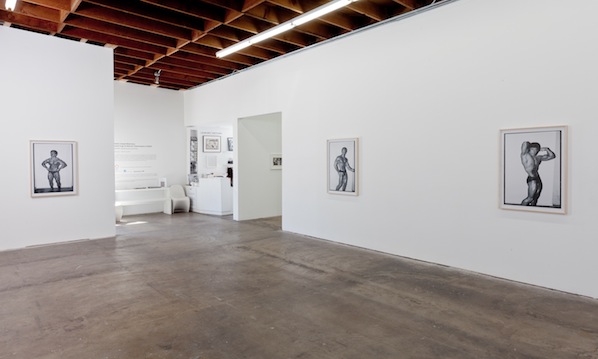
Installation shot at LAXART - February, 2012. All images courtesy of the artist and LAXART.
MG: Do you prefer the gallery model of LAXART (small, committed and focused non-profits) to the commercial gallery model? Can you articulate what a gray area between institutions and commerce in art might look like?
DJM: I don't think we should put ourselves in the binary of either/or. Both have their purposes and serve a great number of artists. The real question is how to not be bound to either of these two systems and at the same time utilize them. This is the moment to invent as many new and different simultaneous means of the dissemination and exchange of ideas and art. One very interesting idea/example happening right now is the Berlin Biennial. This seems to address your question perfectly, it is an institutional event curated and not at the same time. This means there is an air of unpredictability to having an open call of work and the result will be filled in by numerous scenarios. There are many good ideas being discussed these days by curators and organizers of art events. It becomes troubling when the ideas are not being put into practice and when the final lists of those included are released. Then you realize the tendency is to constantly revert to putting in blue chip artists and/or very predictable conclusions when it is all said and done. If the ideas are not truly tested in the field and embraced what good are they? It would seem at that moment we all become armchair academic lumps of flesh merely getting thought the day basking in the comfort and softness of our own self-deception. We are in the second decade of the 21st century... why are we not bursting with ideas of an unimaginable future???
